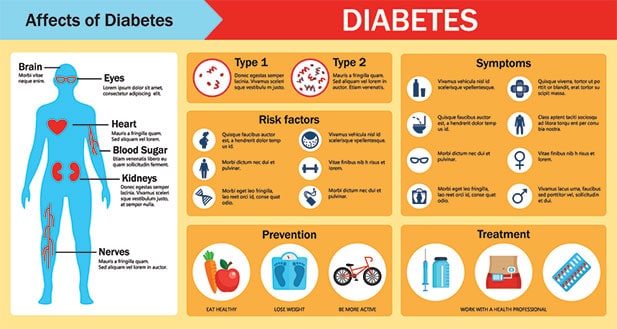Recently researchers from Finland and Sweden have discovered that diabetes is five separate states of endocrine system disruption.
Though we usually think of diabetes in terms of Type 1 and Type 2, there are many different levels of damage that can occur at the islet cell level in the pancreas. This is where the beta cells are made, which produce insulin. When they are damaged or die off, diabetes is the result.
Contents
Move over Type 1 and Type 2 Diabetes
Type 1 Diabetes is a complete destruction of cells in the pancreas that make insulin. Type 2 Diabetes includes insulin resistance where some insulin is made but the body can’t use it properly.
Learning about the new levels of destruction that occur and identifying the five different types of diabetes will help to better tailor specific treatment to specific levels based on how much destruction has occurred in the person with diabetes.
The scientists' discoveries are still just the start of determining what treatments will result for persons with diabetes based on their findings. It will still take many years to come up with treatments based on the research.
Through the Swedish Lund University and the Finnish Institute for Molecular Medicine, researchers studied over 14,700 patients and drew their blood for analysis.
I recommend reading the following pieces:
New Cluster System to classify 5 types of diabetes
The Lancet Diabetes and Endocrinology Journal published the study, demonstrating five clusters of diabetes. The clusters were described by the researchers as the following:
Cluster 1
Type 1 Diabetes (the most severe type of the disease resulting in destruction of all insulin producing beta cells), was defined as Cluster 1.
Usually this develops in young children and can effect those through the ages of mid-twenties. These are young people who are of a healthy weight and mostly have no apparent medical issues before the development of the severe symptoms of Type 1 Diabetes, which resulted from an auto-immune insult to the pancreas at the beta cell level.
Cluster 2
Cluster 2, as would be expected, were the group with Type 2 Diabetes. This cluster of diabetes refers to individuals who are severely deficient in insulin production, but not as bad as those with Type 1.
They have beta cell destruction like those with Type 1 Diabetes. A combination of beta cell destruction that is not auto-immune related and insulin resistance is the hallmark of this cluster.
The difference is that an autoimmune response is not the cause of the cellular death. This group is generally young, have a normal Body Mass Index or BMI, but have a difficult time of making insulin.
Cluster 3
Cluster 3 is identified as those individuals who are primarily insulin resistant. In other words, their body doesn’t use its own insulin very well. They are usually overweight, and their body has a hard time using the insulin due to the excess weight.
Cluster 4
This cluster defined those with “a few extra pounds,” but who were not severely obese or overweight. They still had some insulin resistance going on, but not quite to the level of patients belong to Cluster 3.
Cluster 5
Cluster 5 encompasses those who are elderly and have a mild form of diabetes. Age-related beta cell destruction happens and often results in a milder form of the disease than if it were developed in middle age.
Interesting study tidbits
The study produced some interesting findings related to which organs can be affected the most based on which cluster your diabetes falls in.
Type 2 Diabetes
Related to Type 2 Diabetes, the large-scale study showed that beta cell damage was the main cause of diabetes rather than being overweight. This is why this group will have treatments similar to those with Type 1 Diabetes in most cases, though they may also have oral diabetes as medications.
However, it’s unclear what the relationship between being overweight and its affect on beta cell damage is.
Additionally, related to Type 2, or in this case, Cluster 2, the most common complications found were blindness and renal failure (kidney disease). This helps in identifying the necessary screenings that the person needs to have done based on where they fall in the Cluster classification system.
What’s next?
Next on the horizon, researchers will work to specify treatments for each cluster identified. Understandably, milder forms would be treated less intensely, and more severe clusters from Cluster 1-3 would be treated at a more extensive level.
Limitations of the study
The study was completed using people with diabetes from Sweden and Finland. Risks for diabetes around the world vary by country and region. South Asians, for example, have an extremely high rate of diabetes.
Therefore, studies will need to be replicated across various worldwide populations to see if there are similar patterns or other assumptions to be made. It could mean up to as many as 500 clusters are identified through genetic factors and environmental issues such as contamination of water sources with industrial chemicals.
A look on the bright side
Findings pose a brighter future for risk reduction of the complications of diabetes moving forward. As more research is conducted on varying populations and more clusters are added for different types based on different areas of the world, there can only be a better understanding of diabetes in general, which could eventually push towards a cure.
Further reading:
Over to you
Give us your take on the new cluster classification system for diabetes. Which one do you believe that you fall into? Leave us your burning thoughts in the comments section below. We hope you are keeping up with the myriad of diabetes research and news out there. We aim to help you do that. Also remember to share this article with those who might find it helpful.
TheDiabetesCouncil Article | Reviewed by Dr. Jerry Ramos MD on June 01, 2020
References









